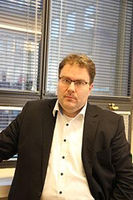Canadian Friends of Finland (Toronto)
Devoted to the promotion of friendship, understanding and cooperation between the peoples of Canada and Finland.

- This event has passed.
An Evening with Finnish Studies – Oct 5
October 5, 2017 @ 6:30 pm - 9:00 pm

Finnish Studies at University of Toronto & Canadian Friends of Finland Education Foundation (CFFEF)
jointly welcome you to
An Evening with Finnish Studies
Time: Thursday, October 5th, 2017 at 6:30pm
Place: Alumni Hall 100, St Michael’s College
121 St Joseph Street, University of Toronto

Implementing the Helsinki City Plan
Rikhard Manninen
Head of Strategic Urban Planning,
City of Helsinki, City Environment sector, Finland
Helsinki, the Capital of Finland, is one of the fastest growing capitals in Europe. Manninen will talk about the new Helsinki City Plan; the general plan for future land use and transportation, for the next 30 years. In the year 2050, the whole Helsinki region will be home to 2 million inhabitants and over 1 million jobs!

Transparency First, Open City Plan Process in Helsinki
Heikki Mäntymäki
Communications Manager,
City of Helsinki, Environment Sector, Finland
In his talk, Mäntymäki will introduce the four-year process of designing and drafting the Helsinki City Plan. Mäntymäki will present the various interactive methods employed during the planning process. Every citizens’ view is important!
Free admission. Reception with coffee and pulla follows.
Everybody welcome!
Please consider a donation to Finnish Studies at the U of T by giving to CFFEF.
R.S.V.P. by phone 416-926-1300, ext 3372 or click to email.
Abstracts
Implementing the Helsinki City Plan
Rikhard Manninen, Head of Strategic Urban Planning, City of Helsinki, City Environment sector
Helsinki is the capital city of Finland with its 630 000 inhabitants. It is one of the fastest growing capitals in Europe. Helsinki City Council approved a new City Plan for the city in October 2016.
The new City Plan is a comprehensive general plan for future land use and transportation. It includes a vision that sets the direction for the city’s growth over the next 30 years. The vision includes the idea of Helsinki as a network city of rail traffic with an expanding strong main center. The vision also examines the city as part of the city region, as a part the network of European big cities and one of the global hubs with great flight connections to Asia and one of the busiest passenger ports in Europe.
The City Plan makes it possible to have approximately 860,000 inhabitants and 560,000 jobs in Helsinki in 2050. Helsinki will become a denser city than it is today, with several district centers connected by efficient public transport and still preserving its major green areas. In the year 2050 the whole Helsinki region will be home to 2 million inhabitants and over 1 million jobs.
During the planning process, the new City Plan was named as “The Urban Plan”. One of the major land use solutions, sometimes considered a radical one, makes it possible to transform motorway-like thoroughfares into city boulevards. They will constitute new urban districts that will feature a mixed urban structure consisting of a light-rail-tram, housing, jobs and services.
An implementation plan to guide the larger development areas is under preparation. It will propose how to reach the goals set in the City Plan. It will also define the implementation schedule and order of the major transformation projects. The implementation of the city boulevards step-by-step offers the possibility to support a systemic change in the transportation system of the whole region. The goals set in the City Plan support the use of non-polluting vehicles and reduce the number of privately owned cars. They will also guide the city to invest significantly into rail-based transport.
Transparency First: Open City Plan Process in Helsinki
Heikki Mäntymäki, Communications Manager, City of Helsinki, City Environment Sector
The Helsinki City Plan process was an open and interactive four-year process. A large amount of experience-based information was collected from Helsinki citizens. This is important, as the City Plan will have a very long-term impact on the city’s development. The process has been made more challenging by the fact that the Urban Plan represents a new kind of strategic city plan. It does not allocate zones for different uses with detailed lines drawn on the map. Instead, the City Plan divides Helsinki into one-hectare squares, with the primary intended purpose of land use presented for each.
The City Plan has been drafted in an open and interactive manner. The process has included a large number of various events, and the city plan materials have been extensively published on the web. An online survey was conducted on Helsinki residents, and blogs have served as a platform for discussion.
Young people have had their own events tailored to their interests, city planners have actively participated in events organised by various associations, and the city plan has been the subject of active discussion and debate on various social media platforms. A very broad range of various interactive methods have been employed during the planning process to ensure that citizens can be closely involved in many ways.
The city planners wanted to hear the views of as many citizens as possible to serve as the foundation for drafting the city plan. To this end, the Helsinki 2050 map survey was implemented in late 2013 in the form of an intuitive online application. Visitors could mark the online map with references to good construction locations, important green areas or new traffic solutions, for example. A total of approximately 4,700 people participated in the survey and made more than 33,000 entries in the map. The survey materials have been carefully analysed and all of the material has also been published as open data. The material represents a comprehensive and internationally unique database of citizens’ views on their city’s development.